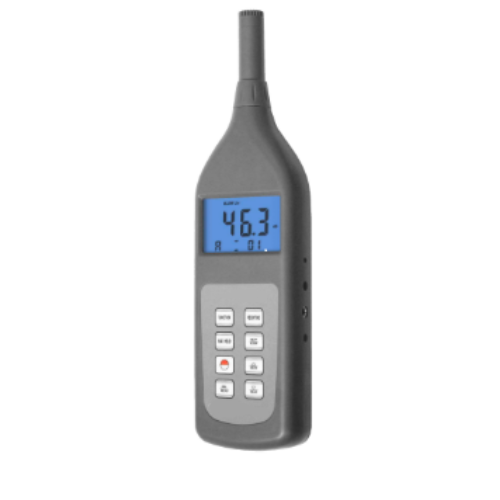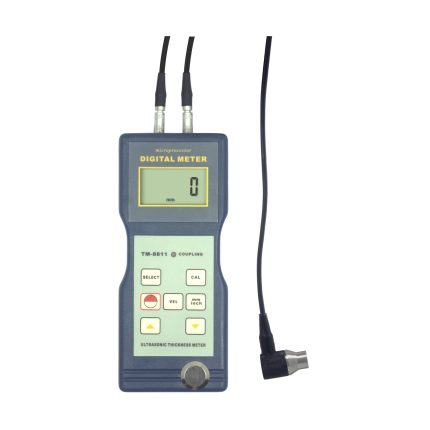Description
Overview
GAOTek Sound Level Calibrator with Large Storage (Auto range Selection) can memorize 30 groups of measurement results and designed to measure the noise level of environment, machinery, vehicles, ships etc. It is also used for industrial environmental protection, construction, transportation, health care, teaching and research department. This is an extremely versatile instrument with wide measurement range from 30 db to 130dB. Equipped with built-in calibration signal and offers four measurement parameters such as Lp for sound level, Leq for equivalent continuous A sound level, Lmax for maximum sound level and LN for percent of all readings over alarm value set.
Key Features
- Compatible with standards of IEC 651 Type 2, ANSI 1.4 Type 2.
- Widely used to test the sound level of environment, machinery, vehicle, ship and other noise.
- Multi-functional. It offers 4 measurement parameters: Lp (sound level), Leq (Equivalent Continuous A Sound Level), Lmax (Maximum Sound Level) and LN (Percent of all readings over alarm value set).
- With adjustable alarm set and an LED alarm output
- This meter permits choice of ‘A’, ‘C’, or ‘Flat’ weighting and ‘Slow’ / ‘Fast’ response time.
- DC output: 0~1.3 V 10 mV / dB.
- Auto range selection and digital display with no guessing errors.
- Manual or automatic shutdown. The tester can be switched off by pressing the power key at any time. On the other hand, the tester can be set to auto power off between 1 to 9 minutes or disable auto power off.
- The tester can memorize 30 groups of measurement results and measuring conditions for later use or download to PC.
- Can communicate and transfer data with PC computer for statistics, printing and analysing by the optional cable and the software for RS232C interface.
Technical Specifications
|
Measurement Parameters |
Lp – general sound level measurement | |
| Leq – Equivalent sound level measurement | ||
| Lmax – maximum sound level measurement | ||
| LN – statistical sound level measurement | ||
|
Measuring Range |
Lp – Ordinary sound level |
A weight: 30 ~ 130 dB |
| C weight: 35 ~ 130 dB | ||
| Linearity: 40 ~ 130 dB | ||
| Leq – Equivalent sound level | 30 ~ 130 dB (time optional 10 seconds, one minute, 5 minutes, 10 minutes, 15 minutes, 30 minutes, 1 hour, 8 hours, 24 hours) | |
| LN – statistical sound level measurement | 0 ~ 100% | |
| Resolution | 0.1 dB | |
| Accuracy | 1 dB | |
| Frequency Weighting | “A ” / “C ” / “F ” (Flat) | |
| Time Weighting | FAST: 125 mS, SLOW: 1 sec | |
| Microphone | 12.5 mm condenser microphone | |
| Memory Function | Group 30 data | |
| Built-in Calibration Signal | 94 dB | |
| Frequency Range | 20 Hz to 12500 Hz | |
| Alarm Settings | 30 dB ~ 130 dB | |
| Alarm Output | LED optional relay contacts | |
| DC Output | 0 V ~ 1.3 V, 10 mV/dB | |
| Power Supply Voltage Indication | Low Voltage Indication | |
| Power Supply | 4 x 1.5 V AAA (UM-4 batteries) | |
| External Power Jack | 6 V, DC, 100 mA | |
| Size | 9.29 in x 2.48 in x 0.90 in (236 mmx 63 mm x 23 mm) | |
| Weight | 5.99 oz. (170 g ) | |
Additional Information
Front Panel Description


MEASURING PROCEDURE
- Press the power
 key and release to switch on the power.
key and release to switch on the power. - Check whether the function selected is right. If not, change it by depressing the key.
 The default setting is Lp, weighting A, Fast.
The default setting is Lp, weighting A, Fast.
Lp – current sound pressure level.
Leq- Equivalent Continuous a Sound Pressure Level, i.e. Arithmetically mean value in a period of time set.
LN- Statistic analysis, i.e. What percent of all measurement values are larger than or equal to the alarm value set by the user? For setting the alarm value, please refer “How to set the alarm value”. - Check whether the weighting is right. If not, change it by depressing the key to select ‘A’, ‘C’ or ‘Flat’. With ‘A’ weighting selected, the frequency response of the meter is similar to the response of the human ear. ‘A’ weighting is commonly used for environmental or hearing conservation programs such as OSHA regulatory testing and noise Ordinance law. ‘C’ weighting is a much flatter response and is suitable for the sound level analysis of machines, engines, etc.
NOTE: Weighting ‘A’ will be automatically selected when measuring Leq. - Use the key to select a Fast (125 ms) or a Slow (1 second) response time. Select Fast to capture noise peaks and noises that occur very quickly. Select the Slow response to monitor a sound source that has a consistent noise level or to average quickly changing levels. Select Slow response for most applications.
- The reading is the peak one if the icon `max` appears on the Display. The reading is an instant value if `max` does not show up. The appearance of symbol `max` is controlled by depressing the key in the process of measurement.
STORING AND RECALLING READINGS
- When in
 state, you can save the reading together with measuring conditions to the memory of the meter by pressing the
state, you can save the reading together with measuring conditions to the memory of the meter by pressing the  Then the icon
Then the icon  changes to ‘M’ automatically while the number of memorized readings increases 1.
changes to ‘M’ automatically while the number of memorized readings increases 1. - No matter in
 state or ‘M’ state, the memorized data can be browsed by depressing the
state or ‘M’ state, the memorized data can be browsed by depressing the  key.The browsing state is marked in ‘R’ on display. When in ‘R’ state, all the readings memorized can be recalled by depressing
key.The browsing state is marked in ‘R’ on display. When in ‘R’ state, all the readings memorized can be recalled by depressing  the key or
the key or  key.
key. - To delete the memorized value in memory, just enter the browsing state and locate the reading to be deleted by the key
 or
or  key, then depress the
key, then depress the  key. If there is an “Err0” on the display, it indicates there is no reading to delete any more.
key. If there is an “Err0” on the display, it indicates there is no reading to delete any more.
HOW TO SET THE LEQ TIME?
Leq is used to assess the rms average noise level over a preset period of time, often the starting point of a noise assessment. To take a Leq measurement, the period of time over which ![]() it is to be made must be selected. The longer the period of measurement time, the more accurate the Leq reading . To set the period of measurement time, just press for about 8 seconds till “Leq” is on the display
it is to be made must be selected. The longer the period of measurement time, the more accurate the Leq reading . To set the period of measurement time, just press for about 8 seconds till “Leq” is on the display ![]() , release the key, then select the set time among 10 s, 1 min, 5 min, 10 min, 15 min, 30 min, 1 hour, 8 hours, 24 hours by depressing Up or Down key. To quit, just depress any key except or key.
, release the key, then select the set time among 10 s, 1 min, 5 min, 10 min, 15 min, 30 min, 1 hour, 8 hours, 24 hours by depressing Up or Down key. To quit, just depress any key except or key.
HOW TO SET THE ALARM VALUE?
The alarm LED is on when the instant measurement value is larger than or equal to the alarm value set. The default setting value at the factory is 85 dB. Users can change it to any value between 30-130 dB by following steps. Depress ![]() for about 5 seconds, release it after “AL” shows on display, then press
for about 5 seconds, release it after “AL” shows on display, then press ![]() key or
key or ![]() key to preset the alarm value as desired. To quit, just depress any key except
key to preset the alarm value as desired. To quit, just depress any key except ![]() or
or ![]() key.
key.
HOW TO SET THE TIME OF AUTO POWER OFF?
The default setting for auto power off at the factory is 5 minutes. That means the meter will auto power off 5 minutes from the time of last key ![]() or
or ![]() operation. Users can change it to any value between 1-9 minutes by following steps. Depress for about 10 seconds, release it after “AU O” shows on display, then press or key to preset the time as desired. To disable the function of auto power off, just preset the time to 0. It will not be off automatically and Can only be shut down manually in such a case.
operation. Users can change it to any value between 1-9 minutes by following steps. Depress for about 10 seconds, release it after “AU O” shows on display, then press or key to preset the time as desired. To disable the function of auto power off, just preset the time to 0. It will not be off automatically and Can only be shut down manually in such a case.
CALIBRATION
The standard method to calibrate the meter requires an external ND9 calibrator in addition to a small screw-driver.
- Calibrate the meter by the ND9
- Turn the meter ON
- Put the meter in the ‘A’ weighting mode
- Put the meter in the ‘SLOW’ response mode
- Place the microphone into the calibrator. Turn the calibrator ON.
- Adjust the meter’s CAL potentiometer so that the meter’s display matches the output of the calibrator.
- Calibrate the meter by the built in signal to enter the calibration state, just switch on the meter, depress the
 key till the icon “CAL” is on the display. Then use a screw-driver to adjust the meter’s CAL potentiometer so that the meter displays 94dB.
key till the icon “CAL” is on the display. Then use a screw-driver to adjust the meter’s CAL potentiometer so that the meter displays 94dB.
CONSIDERATIONS
- Wind blowing across the microphone increases the noise measurement. Use the supplied wind screen to cover the microphone when applicable.
- Do not attempt to dismantle the meter yourself. There are no user-serviceable parts inside.
BATTERY REPLACEMENT
- When battery voltage less than approx. 5v, it is necessary to replace the batteries.
- Install the batteries 4×1.5v AAA (UM-4) correctly into the case.
- If the instrument is not to be used for any extended period, remove batteries.
Note: If AC adapter is used, batteries should be taken away.



